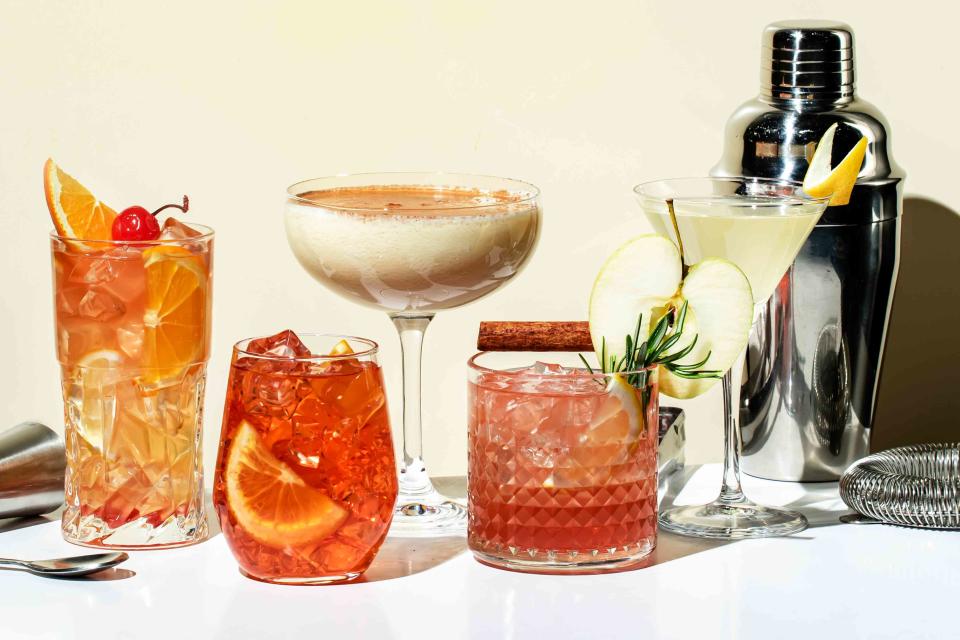How to Find Your Perfect Cocktail, According to Bartenders
Know the classics, consider what kind of night you're looking to have, and use the right lingo.

GETTY IMAGES
If you’ve found yourself Googling “What is aquavit” in a dimly lit bar, we see you. But behind every complicated cocktail menu is a bartender who ultimately wants to make you a drink you’ll enjoy. “Your only responsibility as a guest is to know what you like,” says Haley Traub, general manager at Attaboy in New York City, where drink orders always result from a conversation between guest and bartender.
But what if you're unsure of what you like? You may just need a few nudges in the right direction. We spoke with Traub and Erika Flowers, bar lead at Compère Lapin in New Orleans, about how to navigate a menu — or no menu — like a pro.
First, think about the big picture
Do you plan to hold onto your drink for a longer period, or do you want something light and refreshing? The vibe of your night will determine the style of cocktail you’re looking for.
“I’m trying to see what kind of experience a guest wants to have,” says Flowers. “That’s where I maneuver and pair them with that experience. Do you want to sip on your drink slowly? Let’s go for something spirit-forward. Do you want something more refreshing because you might have a few of them? Let’s go this other route.”
“A huge fork in the road we use to navigate the cocktail process [at Attaboy] is ‘shaken and citrusy’ and ‘stirred and spirit-forward,’” adds Traub.
Shaken drinks typically include a spirit, citrus juice, and sweetener, which are shaken with ice to incorporate the ingredients. Stirred drinks are often made of entirely alcoholic components — think the martini, Manhattan, and Negroni — and are stirred with ice to create a less diluted beverage.
A classic Negroni, for example, includes gin (a spirit), Campari (a bitter liqueur), and sweet vermouth (a fortified wine). Keep in mind that a shaken cocktail doesn’t necessarily mean less booze. Tropical-style drinks like the mai tai — made with a bevy of spirits, liqueurs, and fruit juices — are notoriously potent.
Related: Here's How to Make the Best Martini in NYC
Helpful terms to know when ordering drinks
Up: A drink served without ice
On the rocks: A drink served over ice
Long or tall: A drink made with a higher ratio of mixer like soda water and served in a longer glass to hold the extra volume. Long drinks also include highballs, like the gin & tonic, which are generally made with one to two ounces of a spirit topped with a carbonated mixer.
Knowing the classics can help you order a better drink
The classic cocktail Rolodex is only so large, and almost any drink on the menu is going to be a variation on something you already know. “The best possible jumping-off point that gets us into our modern classics is our Prohibition-era classics that are the foundation of all cocktails at this point,” says Traub.
Some of the cocktail families that Traub trains her bar staff on are the sour (spirit, sweetener, citrus juice, served up or on the rocks); the Collins (essentially a sour lengthened with soda water and ice); and the rickey (a sour with lime juice, soda water, and ice, with or without a sweetener). Classic cocktails include the martini, the Old Fashioned, the Manhattan, the gimlet, and the daiquiri.
From there you can get into other classics and modern classics. The Rob Roy, for example, is a variation on a Manhattan with Scotch in place of rye whiskey. The Penicillin (created by Attaboy co-founder Sam Ross) is a riff on the whiskey sour with honey-ginger syrup and an Islay Scotch float.
Related: When to Shake Or Stir Your Drink
When it comes to spirits, keep an open mind
Even if you think you only really like tequila or gin, stay open-minded. “There are so many different flavor profiles — you may have had a gin that’s super juniper-forward and there’s this new citrus-forward one I want you to try,” Flowers explains. The same goes for any spirit. If you usually tend toward bourbon, you may find that you enjoy barrel-aged expressions of other spirits, like añejo tequila or dark rum.
Think about cocktails like food
Even if you’re unfamiliar with spirits or cocktails in general, you still have flavor preferences, and you can rely on them when you’re talking to the bartender. “Do you tend toward fruity things? Do you like creamy, dessert-y things or herbaceous vegetables?” Traub says. “There’s a really fun way to steer guests into the cocktail world based on flavors they know they like.” Flowers adds that it can also be helpful to tell your bartender if you have aversions to flavors like bitter, savory, or smoky.
Related: 9 Things Bartenders Wish You Knew About Tipping
“Not-too-sweet has become an all-encompassing term when really it’s kind of an umbrella,” says Traub. Also, remember that your version of too sweet may differ from your bartender’s. While you can say you prefer your drinks on the drier side, it can be helpful to clarify what you mean, says Traub. Are you looking for something bitter? Does your palate lean toward more tart flavors than sweet when you’re drinking a sour like a margarita?
Above all, don’t be intimidated! “We do this because we love it and we want to share it,” says Traub. “So don’t be afraid to ask questions. Even if you think it’s a silly question I guarantee I’ve been asked sillier.”
For more Food & Wine news, make sure to sign up for our newsletter!
Read the original article on Food & Wine.


